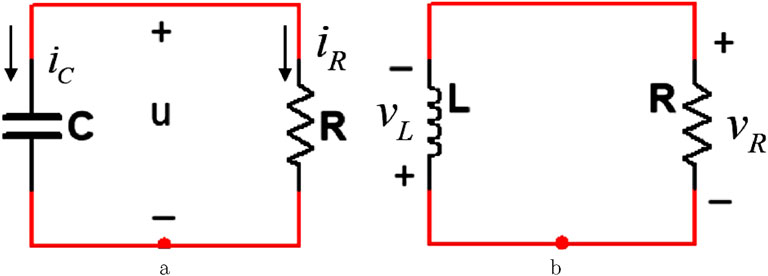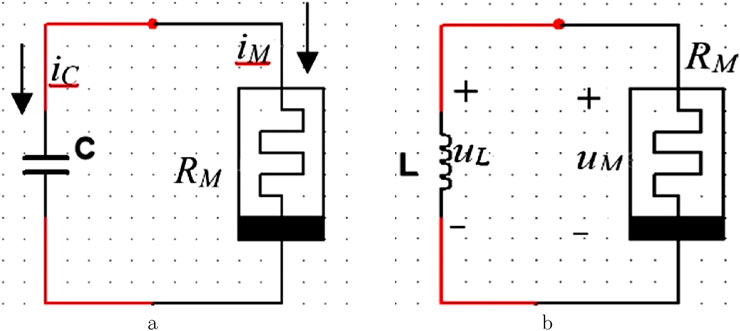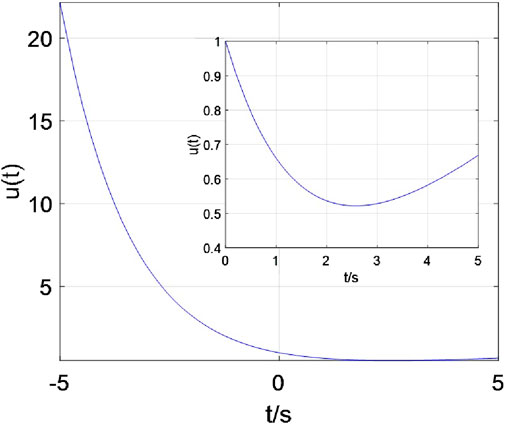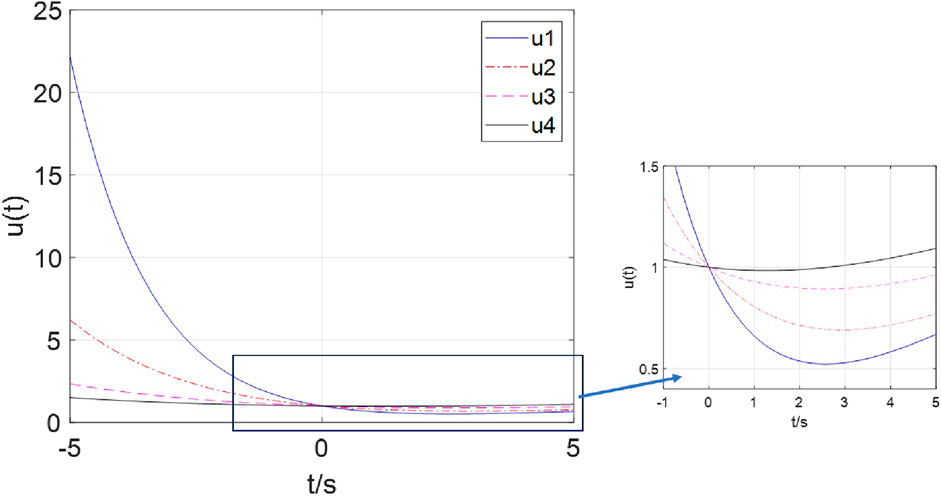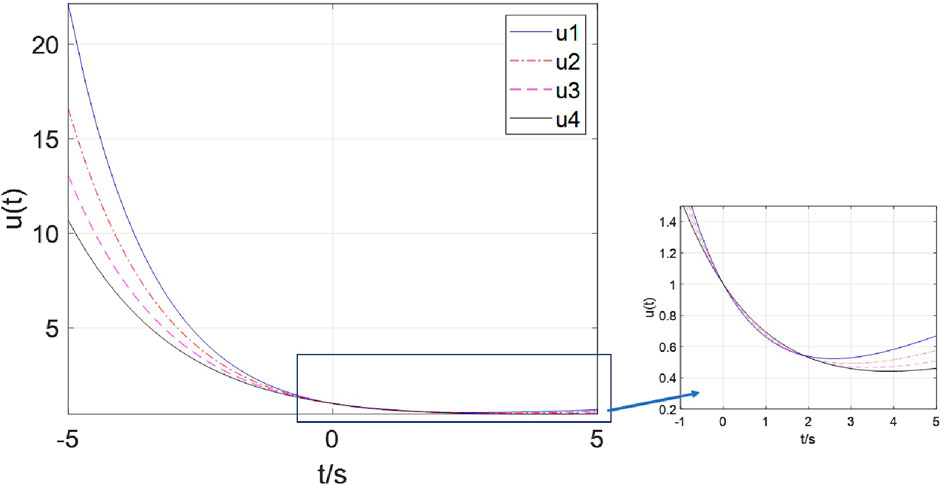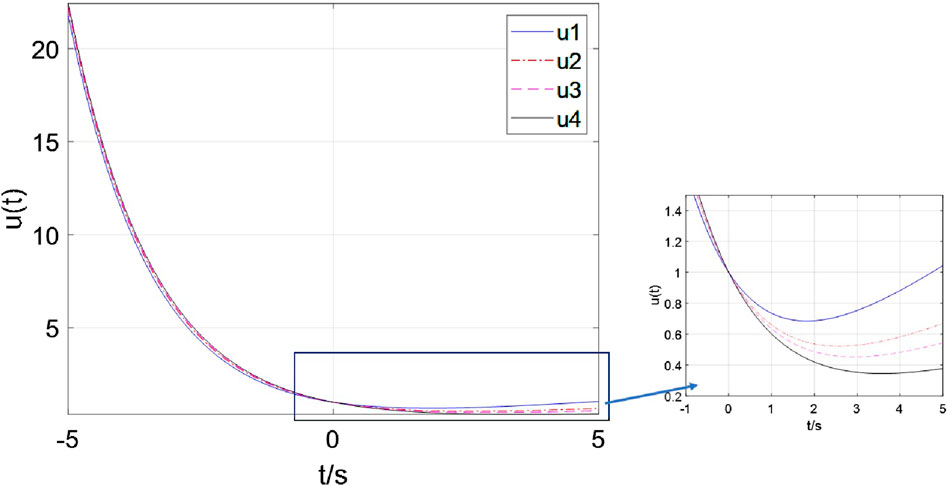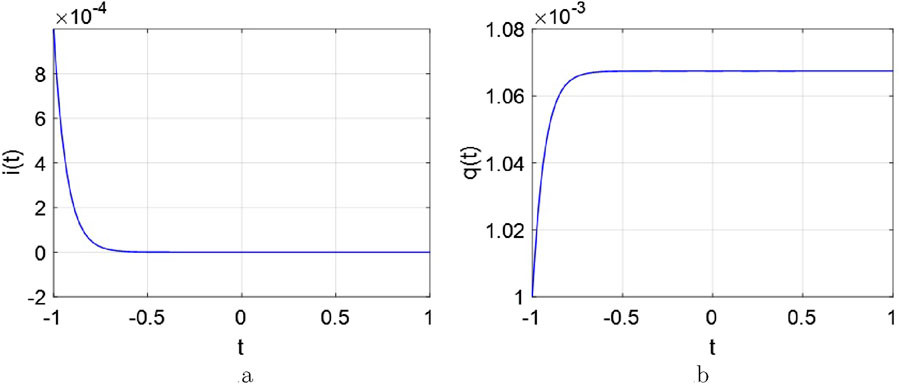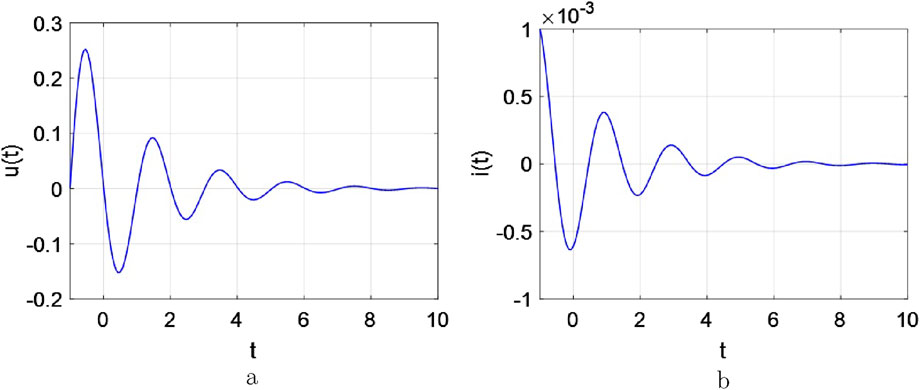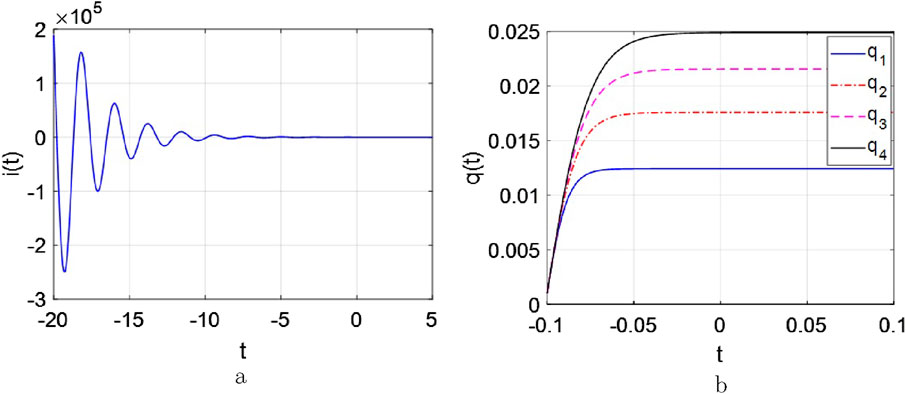- 1Aerospace Times FeiHong Technology Company Limited, Beijing, China
- 2Chinese Academy of Sciences Institute of Automation, Beijing, China
- 3College of Electrical and Electronic Engineering, Changchun University of Technology, Changchun, China
Introduction: Memristor systems and their application circuits have attracted growing research interest. When a memristor circuit/network is designed, both memristors and conventional electronic components are inevitably required, particularly energy storage elements (e.g., capacitors and inductors). It has found that most existing studies focus on oscillatory phenomena generated by memristive systems, such as chaotic attractors, period-doubling oscillations, spiking and bursting oscillations. However, there is a notable lack of literature exploring and analyzing the energy exchange between these components, as well as the resulting oscillatory behaviors and outcomes arising from such interactions. It is well known that the unit of a memristor, like that of a resistor, is the ohm (Ω). In general circuits, the energy exchange between resistors and energy storage elements can induce nonlinear behaviors such as step functions, damping phenomena, both of which stem from the energy exchange between resistors and capacitors/inductors. So, when a memristor (though physical implementations are rare, several classic mathematical models exist) exchanges energy with energy storage elements, will similar behaviors emerge?
Methods: In this paper, to advance the theoretical completeness of memristive systems and take the classical HP memristor model as an example, four source-free circuit topologies integrating memristors with energy-storage elements are investigated deeply. They are categorized into two types: RMC/RML circuits and series/parallel RMLC circuits. Firstly, through mathematical modeling, the four circuits are all found to be governed by transcendental equations. Secondly, two types of four-component source-free circuits are configured and analysis. Finally, the application circuits comprising four fundamental components was configured and explored.
Results and Discussion: Simulation results for the mathematical models of the four circuits demonstrate memristor states (R0, kRd) and energy-storage elements collectively regulate response characteristics, damped oscillatory and decay behavior. The active power and apparent power curves reveal distinct energy exchange behaviors between components, differing fundamentally from conventional RL, RC, and RLC circuits. These findings demonstrate that due to the presence of memristors, such circuits cannot be employed for step response generation, but are exclusively applicable for energy memorization and dissipation. Then, the following conclusion on two types of source-free circuits are demonstrated: (1) capacitor and inductor provide energy (i.e., ϕ and q) to the system, while memristors exhibit hysteretic behavior, collectively and fundamentally co-modulating oscillation modes and attractor phenomenon; (2) The dual characteristics of memristors—memory capability and energy dissipation—endow them with the potential to break the von Neumann bottleneck, making them essential candidates for implementing next-generation neural networks and AI systems. Finally, the application circuits reveal that even within the same circuit, varying memristor placements can lead to distinct topological configurations and divergent nonlinear output behaviors. This phenomenon further validates the unique characteristics of memristors as an emerging field. These findings establish a solid theoretical and experimental foundation for future exploration and development of memristive systems, including next-generation neural networks, artificial intelligence applications, and aerospace technologies.
1 Introduction
The memristor has been hypothesized as the fourth fundamental circuit component [1] and named. Its fingerprint is a pinched hysteresis loop [2], which is the recovery of pure resistance (no hysteresis) for high frequencies [1, 2]. Subsequently, the HP-memristor was proposed and fabricated as a canonical model. Due to the special electrical properties of nonvolatile memory and extraordinary nonlinearity, the memristor is usually adopted to design the artificial neural networks, memristive circuits, oscillation circuits and employed for unmanned aerial vehicles and motors. Currently, the discussion is focused not only on the application to computation and memory storage, but also on the fundamental role in nonlinear circuit theory. For instance, real synaptic circuits [3, 4]. biological neurons [5–8], behaviors of some neural network models [9, 10], and even some complex systems [11, 12] with memristors or memristor emulators [11, 13–16, 29]. Also, some meaning and interesting nonlinear behaviors and application have also been discovered and published [17], integration to mention just a few.
Totally, all above involved results contributed to improving the circuit theory and exploring related applications in the fields of circuit engineering, such as mathematics, physics, and aerospace circuits. According to the definition of the memristor, whose value depends on its internal parameter, which in turn has to evolve dynamically according either to current and voltage [2]. In other words, when the memristor was configured into one real circuit, the relationship
Furthermore, it has found that most existing studies focus on oscillatory phenomena generated by memristive systems, such as chaotic attractors, period-doubling oscillations, spiking and bursting oscillations. However, there is a notable lack of literature exploring and analyzing the energy exchange between these components, as well as the resulting oscillatory behaviors and outcomes arising from such interactions. It is well known that the unit of a memristor, like that of a resistor, is the ohm
The remainder of this paper is organized as follows: In Sec II, the information on HP memristive system and two types of general source-free circuits are presented. In Section III, both source-free circuits are introduced, that is,
Notably, all the curves in this paper are tested by the software MATLAB R2018a Version, which is a programming and numeric computing platform used by millions of engineers and scientists to analyze data, develop algorithms, and create models.
2 HP memristor and gerenal source-free circuits
As both one fundamental 2-port electric component and the classical model, HP-memristor
where, there are two regions: one region with a high dopant concentration with low resistance
In order to study the universality of this class of memristive systems, it can be re-written as
where the variable
The important trajectory curves are depicted in Figure 1.
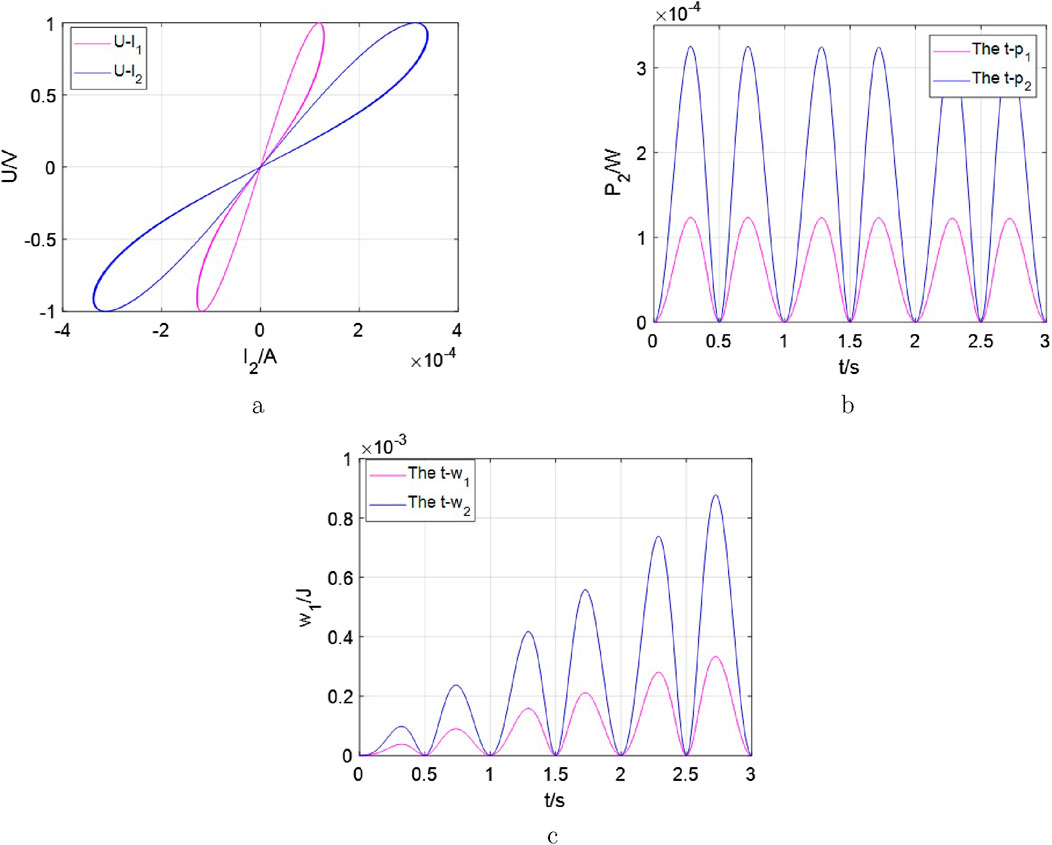
Figure 1. Several important relationships between different variants for the memristors,
From Figure 1, it can be seen that these curves are the fingerprints, the dissipated power and energy absorbed in time-domain graphs for the single memristor. They are so complex but cannot be applied directly like the other general discrete elements. Due to the characteristics of the memristive system, its power exhibits a frequency doubling phenomenon. Thus, the related basic fundamentals should be examined as soon as possible via the
In circuit theory, for an ordinary circuit, there are two excitation methods. One method involves independent sources. The other utilizes the initial conditions of storage elements within the circuit, which are so-called source-free circuits. When energy is initially stored in capacitive or inductive elements, this stored energy drives current flow, which is gradually dissipated in resistors. The rate of dissipation can be calculated by Kirchhoff’s laws. This way has been considered as a sufficient, powerful set of tools to analyze a large variety of electric circuits all the time. Now, this method could be utilized to analyze the following circuits, such as
Observing from Figure 2a, when the initial condition is

Figure 3. The natural response of the
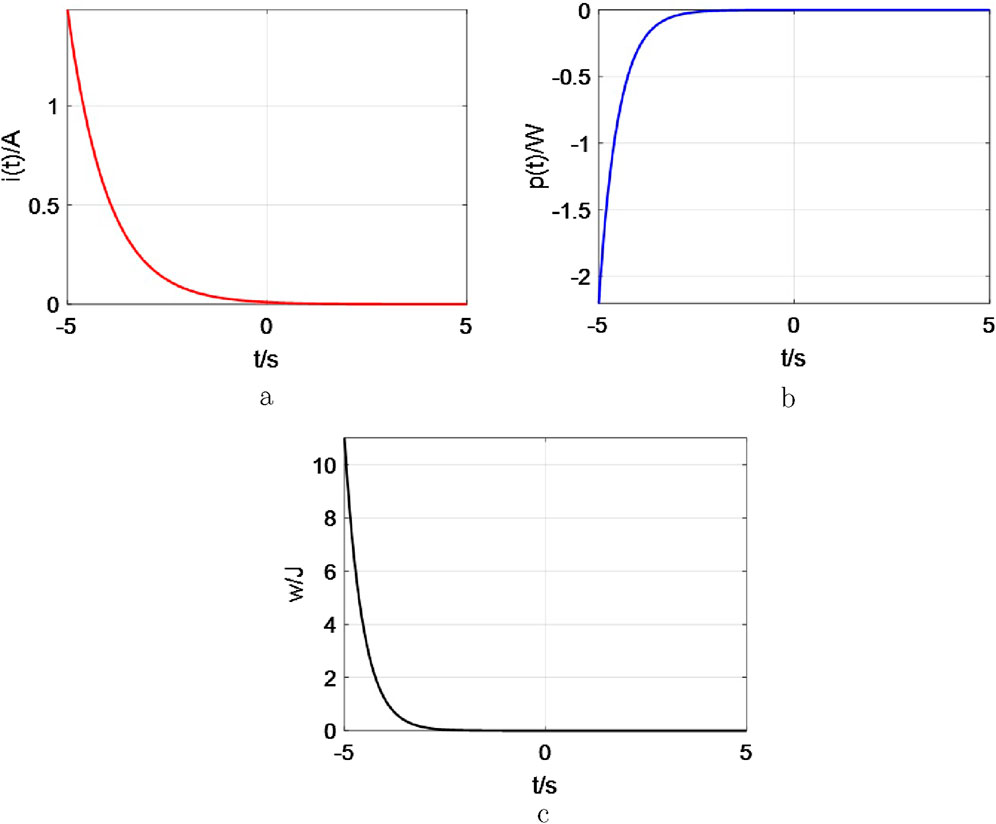
Figure 4. The natural response of the
For the source-free
For the source-free
Observed from Figures 3, 4, when
The above has already provided a complete description for the properties of classical first-order circuits. Next, we pose a question: when resistors are substituted with memristors (e.g., HP memristors), what kind of conclusions could be obtained? For this purpose, the following
3 The source-free
3.1 The source-free
The produced source-free
where, the variable
Obviously, Equation 6 a transcendental equation whose solution can only be computed using approximations and cannot be obtained exactly. The natural response curve of the Equation 5 could be illustrated graphically in Figure 6.
From Figure 6, this response curve is fundamentally distinct from that of an
There are three variables related to the decay of the voltage response
(1) when
Observe from Figure 7, When
i. A smaller
ii. A smaller
iii. A certain energy exists to memorize information for the memristor. Therefore, the voltage
(2) when
From Figure 8, when
i. A smaller
ii. A smaller
iii. A certain voltage is required to memorize information for the memristor. Therefore, the voltage
(3) when
Observed from Figure 9, when
i. A larger
ii. A larger
iii. A certain energy exists to memorize information for the memristor. Then, the voltage
It should be noted that when applying both
Finally, the dissipated power and the absorbed energy by the memristor for the
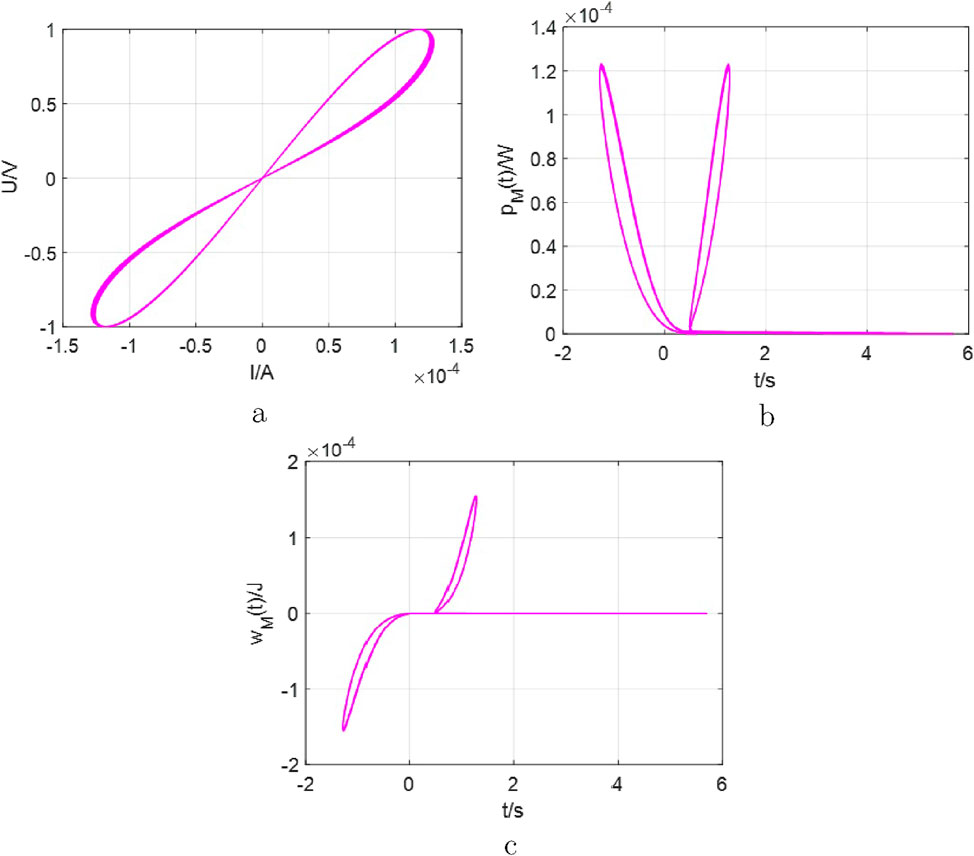
Figure 10. The curves for the
Between Figure 1 and Figure 10a, the fingerprint characteristics have been presented. Observed from Figure 10b, some information could be memorized by
3.2 The source-free
The inductor
Applying Kirchhoff’s Laws
where the variable
As shown in Figure 11, the depicted response curve bears similarities to the general
The decay of the current response
(1) when
Observe from Figure 12, the following conclusion could be obtained:
i. A large
ii. A certain current is required, when a memristor memorizes information. Therefore, the current
iii. The memory characteristics could be occurred by
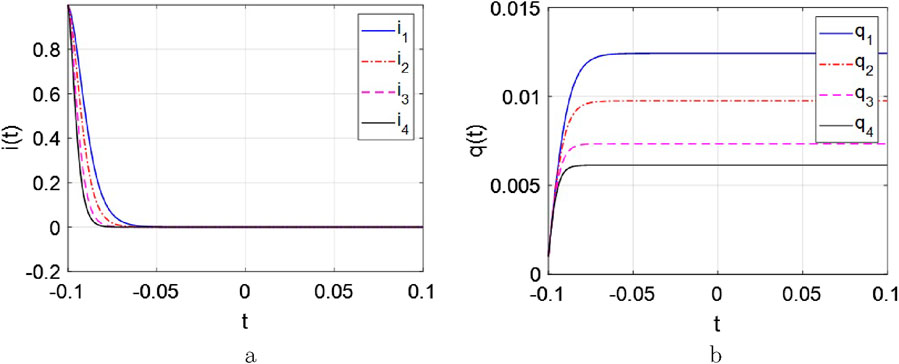
Figure 12. The curves of the current and charge response with
(2) when
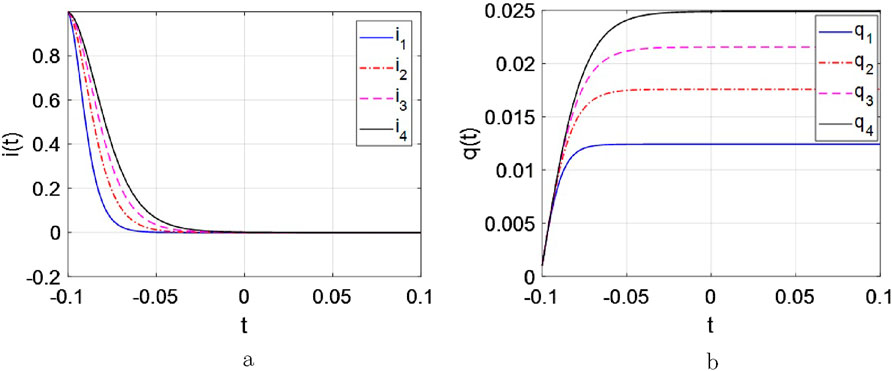
Figure 13. The curve of the current and charge response with
From Figure 13, the similar results could be got:
i. A large inductive
ii. When a memristor is utilized for information storage, the current
(3) when
Observed from Figure 14, the following results could be given as:
i. A large
ii. The energy consumption characteristics exist and are presented by
Finally, Figure 15 presents the dissipated power of the
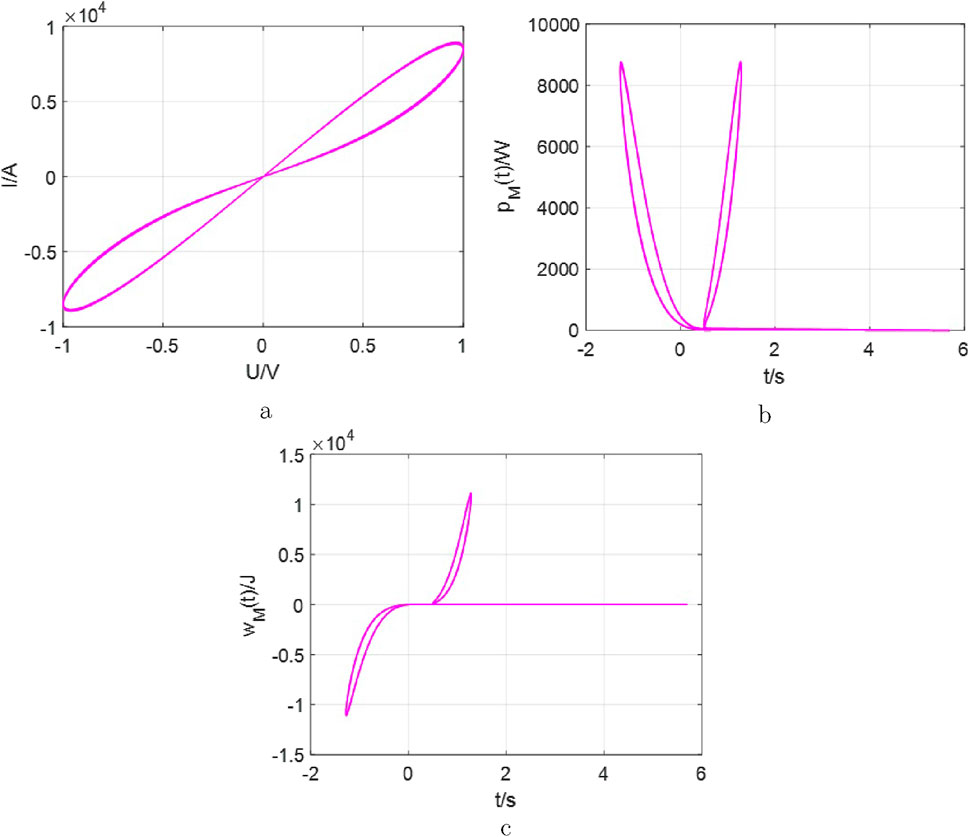
Figure 15. The curves for the
Similar to the
4 The
Importantly, building memristive circuits is inseparable from energy storage components, similarly, the study of source-free circuits cannot proceed without them. In the aforementioned analysis and discussion of the natural response of the source-free circuits, two transcendental equations incorporating memristor models have been established. Additionally, the new time constant for the both circuits has been redefined. In this section, similar to the analysis of

Figure 16. The source-free
4.1 A.Series circuit
Applying Kirchhoff’s Laws
where the variables
There is no doubt that Equation 9 is still a high-order transcendental equation. Thus, the natural response curve could be depicted graphically in Figure 17.
Comparison with a conventional
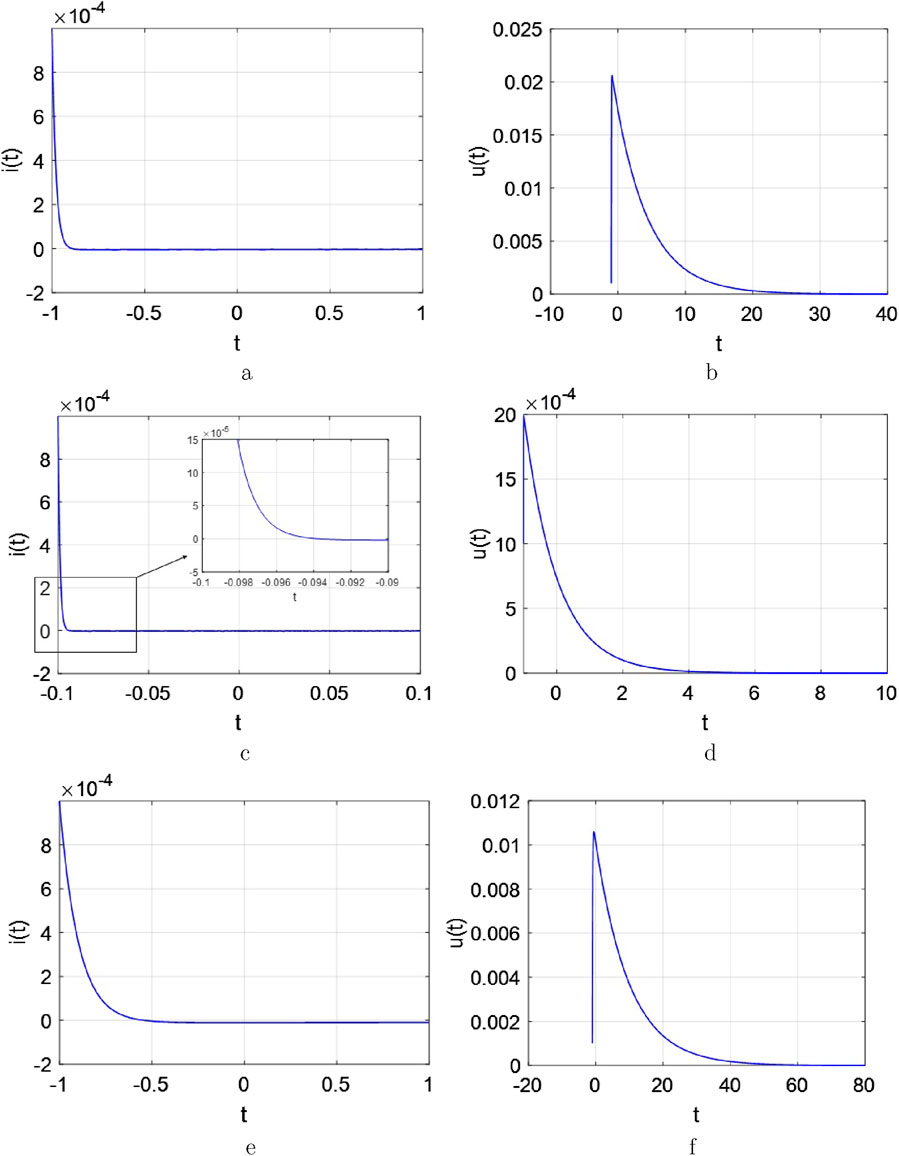
Figure 18. The response of current and voltage curves for the
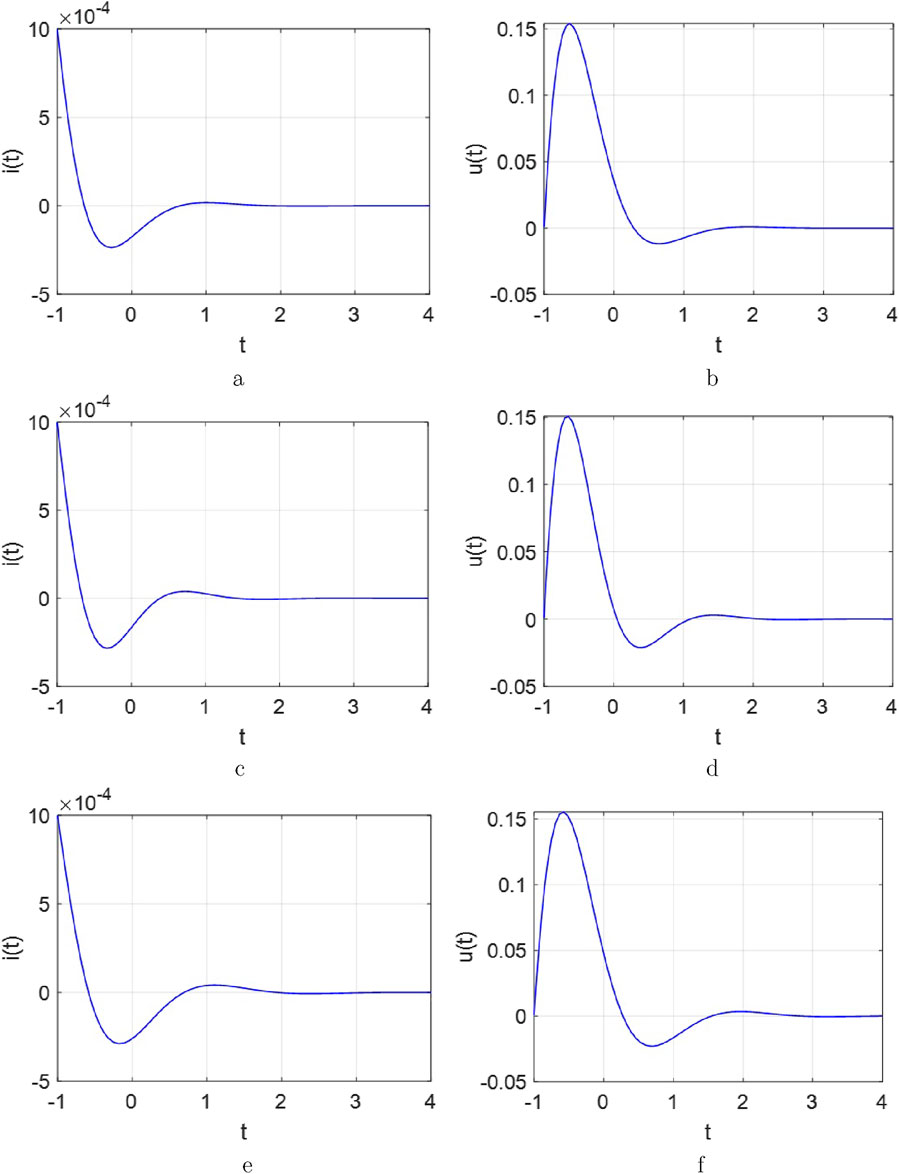
Figure 19. The response of current and voltage curves for the
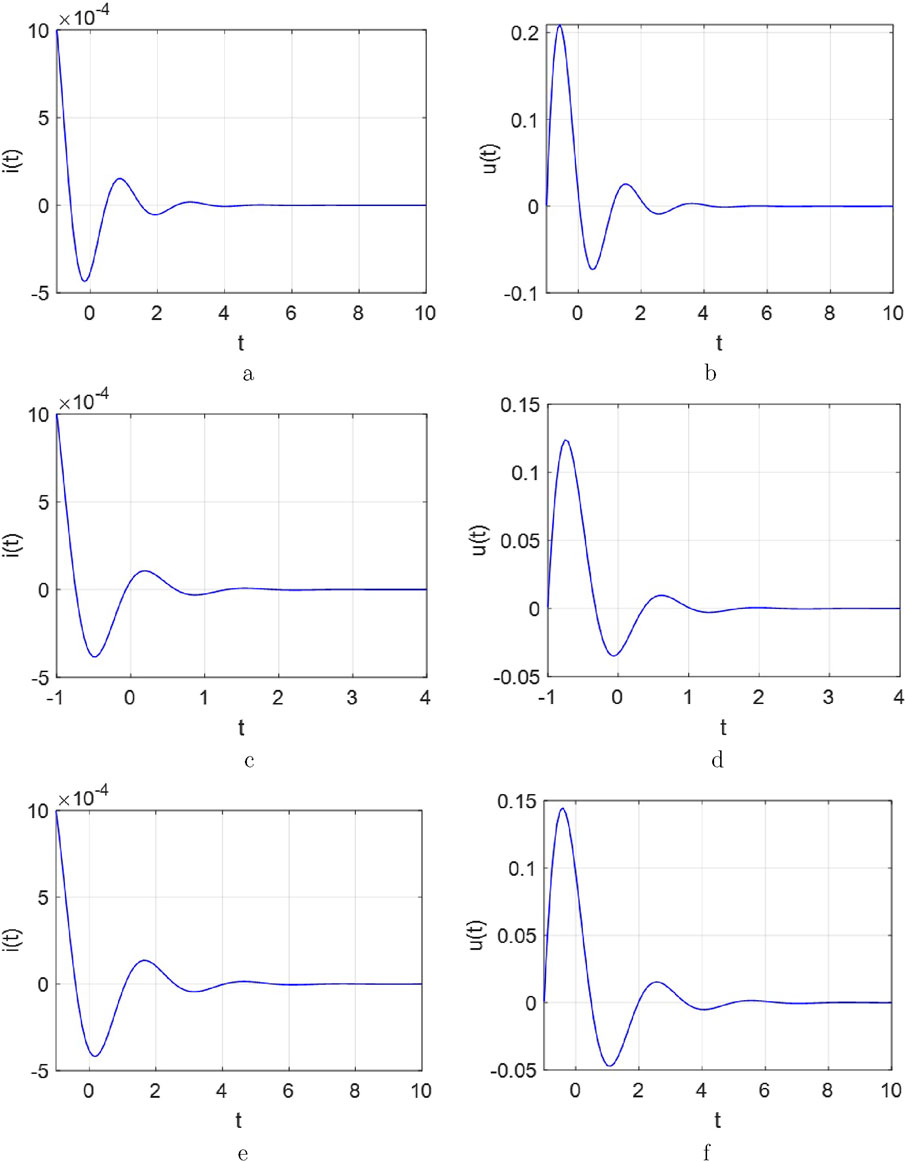
Figure 20. The response of current and voltage curves for the
4.1.1 Overdamped case
When the following conditions are assigned, both response curves of
Observed from Figure 17 and Figure 18, the overdamping phenomenon occurs when the memristance increases (i.e., increasing
4.1.2 Critically damped case
When the following conditions are set, both the current and voltage of the system exhibit maximum and minimum values in Figure 19, respectively. Also, the delays all the way to zero.
Between Figure 17 and Figure 19, the critically damped phenomenon presents immediately when the memristance increases (i.e., increasing
4.1.3 Underdamped case.
The oscillation period in both
Compared with Figure 17 and Figure 20, the underdamped phenomenon has been shown as the same situation.
From Figures 18–20, the special characteristics of the
i. In HP-memristor is known as the linear drift model. When current flows through a designed circuit incorporating energy storage elements and a memristor, a higher-order mathematical model can be derived, which surpasses the complexity of conventional
ii. Similar to the
iii. The damping phenomenon arises because a memristor integrates two functional aspects: memory
iv. The damped oscillation is possible due to the presence of the nonlinear elements (i.e.,
v. All subplots uniformly validate that the same initial conditions but different component parameters would manifest a similar yet quite different output waveform. This variance could be thought as a kind of catalyst to get various application areas in the future, simultaneously revealing characteristics of chaotic oscillations. It further demonstrates the influence of
4.2 Parallel circuit
From Figure 16b, when the conditions
where the variables
Equation 11 is still a transcendental equation. Its solution could be obtained through approximately methods. Now, the nature response curve could be drawn in Figure 21.
Next, we investigate the impact of varying parameters (
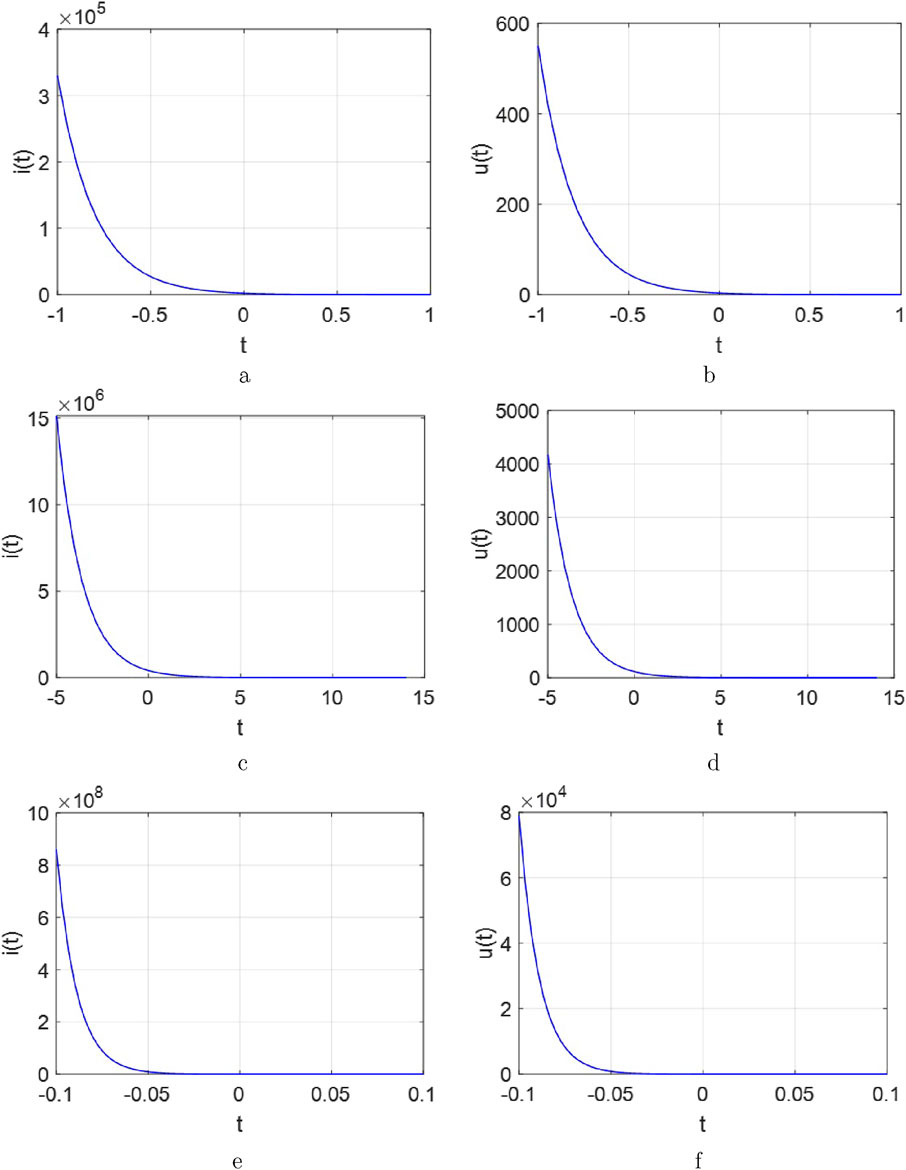
Figure 22. The response curves for the
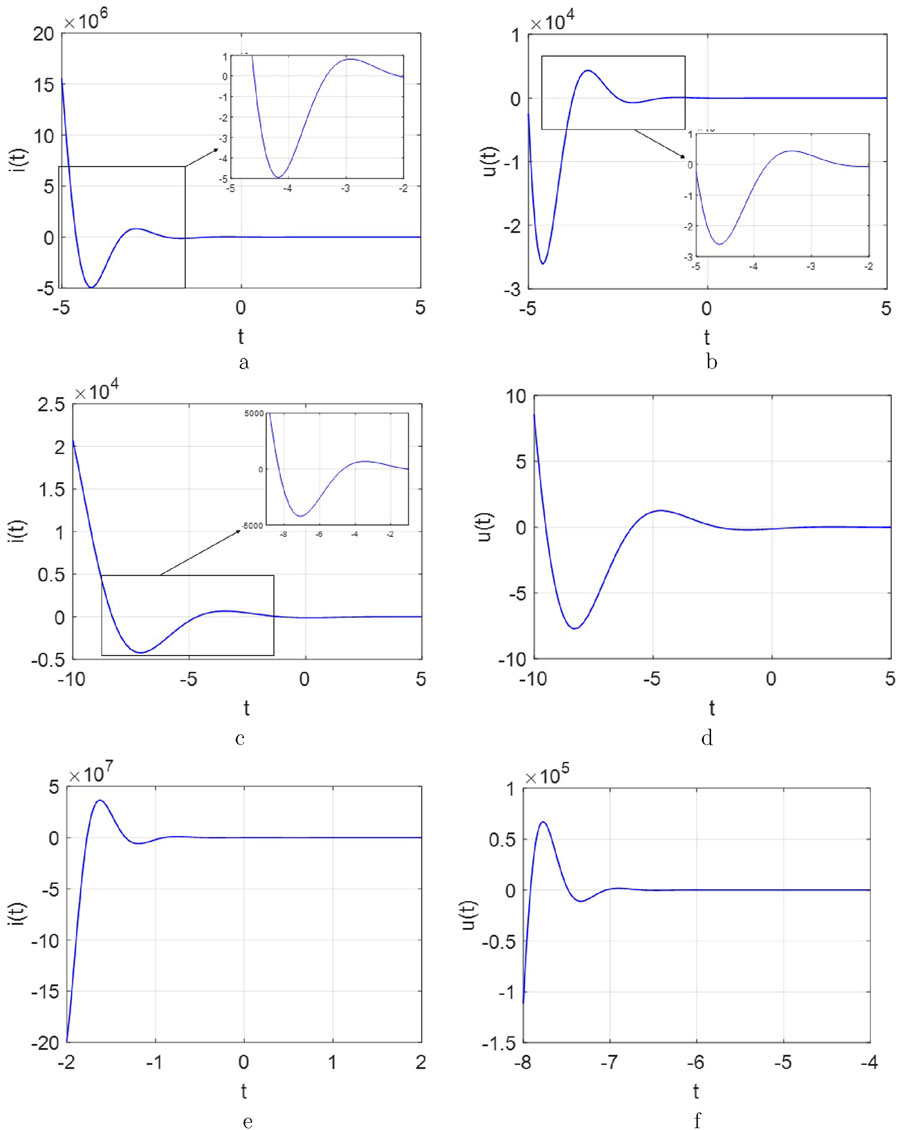
Figure 23. The response curves for the
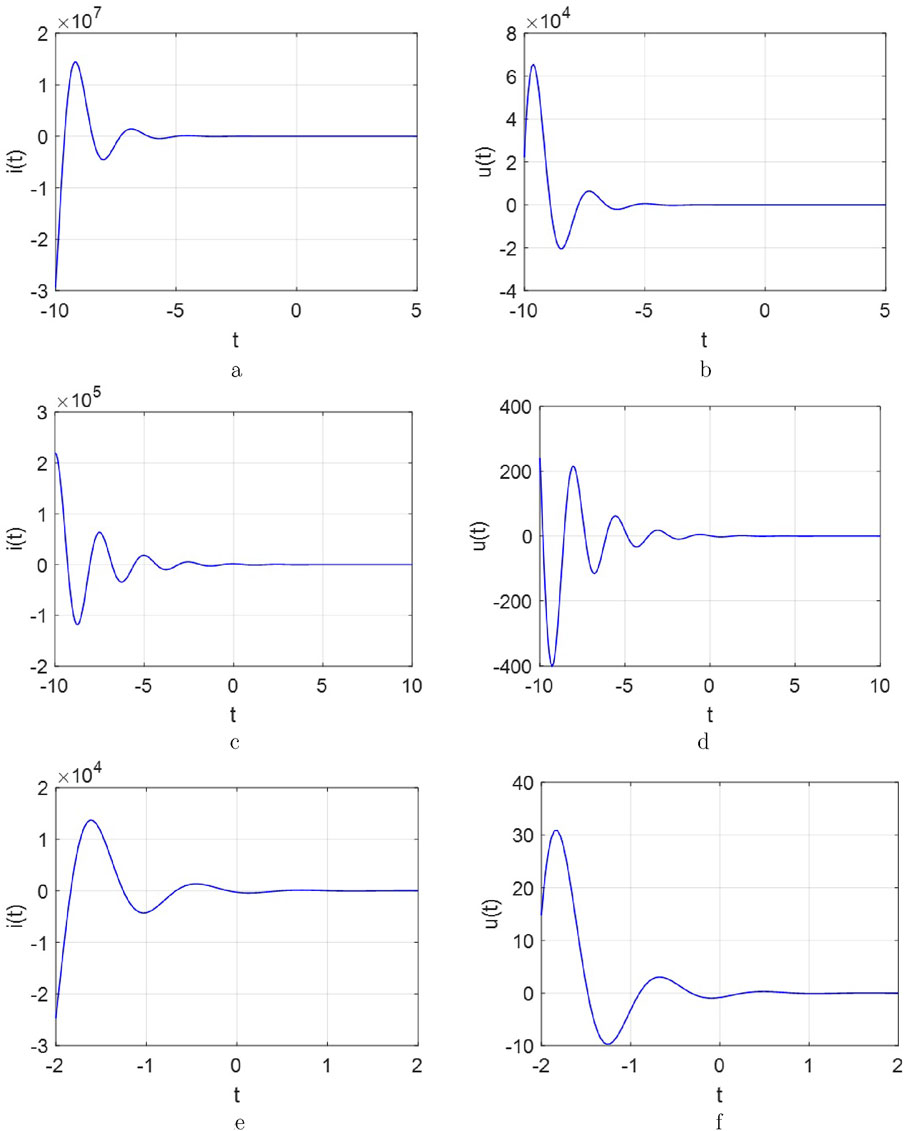
Figure 24. The response curves for the
4.2.1 Overdamped case.
When the following conditions are assigned, both response curves of
Between Figure 21 and Figure 22, the overdamping phenomenon occurs when the memristance decreases (i.e., decreasing
4.2.2 Critically damped case.
When the following conditions are given, both the current and voltage exhibit maximum and minimum values, respectively (see Figure 23). Also, the delays all the way to zero.
Observed from Figure 21 and Figure 23, the critically damped phenomenon have happened when the memristance decreases (i.e., decreasing
4.2.3 Underdamped case.
The oscillation period in both
To summarize the conclusions according to the Figures 22–24 for one
i. Similar to the
ii. The coexistence of memory storage and energy dissipation characteristics in this circuit arises from the dual-resistance structure of the memristor, characterized by
iii. The conditions for achieving overdamped, critically damped, or underdamped phenomena differ from those in
iv. Under identical initial current and voltage conditions but with varying circuit component values, all subplots in the figure were analyzed. These results validate the influence of
5 Application of classic circuits with four fundamental components
A classical four-component application circuit is presented, as shown in Figure 25.

Figure 25. A circuit with HP-memristor. (a) Replacing the Chua diode with an HP memristor. (b) Transposing the positions of HP memristor and resistor.
The following analysis would demonstrate how energy storage elements or memristors influence the memory characteristics and oscillatory behavior. The Figure 25a, this circuit shares the same topological structure as the Chua system, but features a different memristor configuration. Consequently, it also produces different phase trajectory curves, the mathematical model has been built and analyzedin the following form:
Secondly, when transposing the positions of the HP memristor and resistor in this circuits, the mathematical model is given as follows:
Setting the variable
and
For Figure 25a, setting the parameters
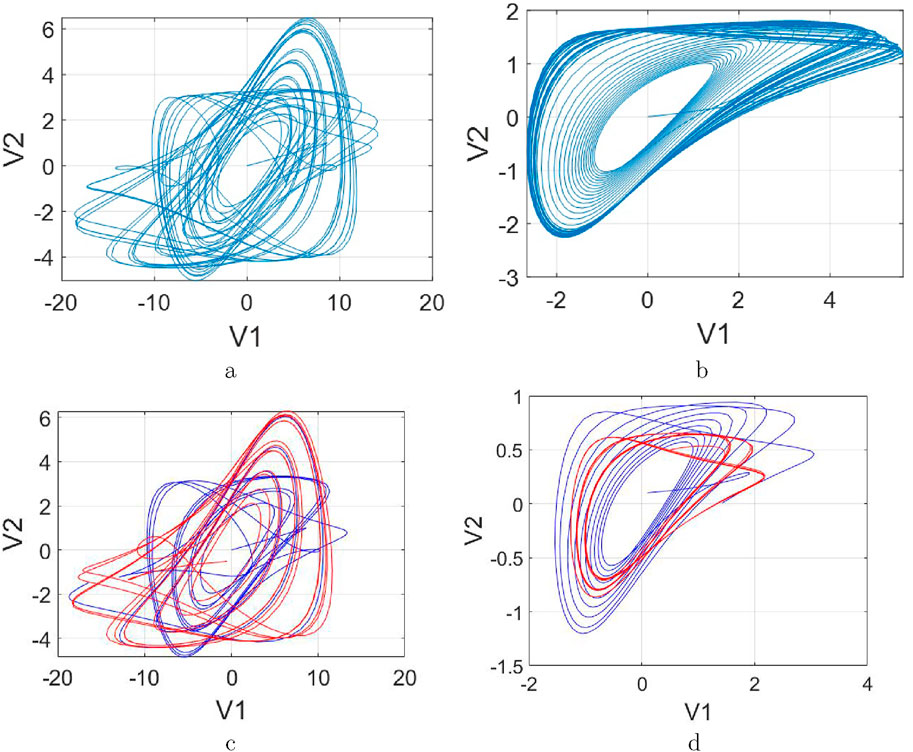
Figure 26. Phase portrait in
These observations demonstrate that as initial values vary, the system not only exhibits irregular oscillations but also manifests chaotic attractors, coexisting attractors in Figure 26c and hidden attractors in Figure 26d. These characteristics serve as critical evidence for the system’s capability to facilitate the construction of complex neural networks with memory properties.
Let
Then, the Lyapunov exponent spectrum corresponding to parametrically configured is illustrated in Figure 28.
This provides another perspective to demonstrate that the chaotic oscillation arises from the energy to transfer energy back and forth between the memristor and energy storage elements. From Figure 28, the
Observed from Figures 29a–c, they illustrate the effect of varying the inductance

Figure 29. The response of voltage curves
Similarly, Figures 29d–f demonstrates the impact of changing the capacitance
6 Conclusion
To advance the fundamental theory of memristive circuits, this study investigates four types of source-free circuits incorporating memristors and energy storage elements following the research methodology of classical source-free circuit analysis.
These circuits are categorized into two groups: one group consists of a memristor combined with a single energy-storing element (denoted as
Data availability statement
The original contributions presented in the study are included in the article/supplementary material, further inquiries can be directed to the corresponding authors.
Author contributions
XG: Writing – original draft, Writing – review and editing, Supervision. YQ: Formal Analysis, Investigation, Writing – review and editing. SL: Data curation, Methodology, Writing – review and editing. WL: Conceptualization, Data curation, Formal Analysis, Writing – review and editing. YS: Investigation, Supervision, Writing – review and editing. YL: Writing – review and editing, Writing – original draft.
Funding
The author(s) declare that no financial support was received for the research and/or publication of this article.
Conflict of interest
Authors XG, YQ, SL, and WL were employed by Aerospace Times FeiHong Technology Company Limited.
The remaining authors declare that the research was conducted in the absence of any commercial or financial relationships that could be construed as a potential conflict of interest.
Generative AI statement
The author(s) declare that no Generative AI was used in the creation of this manuscript.
Any alternative text (alt text) provided alongside figures in this article has been generated by Frontiers with the support of artificial intelligence and reasonable efforts have been made to ensure accuracy, including review by the authors wherever possible. If you identify any issues, please contact us.
Publisher’s note
All claims expressed in this article are solely those of the authors and do not necessarily represent those of their affiliated organizations, or those of the publisher, the editors and the reviewers. Any product that may be evaluated in this article, or claim that may be made by its manufacturer, is not guaranteed or endorsed by the publisher.
References
1. Chua LO. If it’s pinched it’s a memristor. Semiconductor Sci Technology (2014) 49(10):104001. doi:10.1088/0268-1242/29/10/104001
2. Caravelli F, Carbajal JP. Memristors for the curious outsiders. Technologies (2018) 6(4):118. doi:10.3390/technologies6040118
3. Zhang Y, Wang X, Li Y, Friedman EG. Memristive model for synaptic circuits. IEEE Trans Circ Syst.–II: Express Briefs (2017) 64(7):767–71. doi:10.1109/TCSII.2016.2605069
4. Bao H, Zhang Y, Liu W, Bao B. Memristor synapse-coupled memristive neuron network: synchronization transition and occurrence of chimera. Nonlinear Dyn (2020) 100:937–50. doi:10.1007/s11071-020-05529-2
5. Tan Y, Wang C. A simple locally active memristor and its application in HR neurons. Chaos (2020) 30(5):053118. doi:10.1063/1.5143071
6. Huang L, Wang S, Lei T, Li C. Coupled HR–HNN neuron with a locally active memristor. Int J Bifurcation Chaos (2024) 34(2):2450022. doi:10.1142/S0218127424500226
7. Shama F, Haghiri S, Imani MA. FPGA realization of Hodgkin-Huxley neuronal model. IEEE Trans Neural Syst Rehabil Eng (2020) 28(5):1059–68. doi:10.1109/TNSRE.2020.2980475
8. Yu F, Shen H, Yu Q, Kong X, Sharma PK, Cai S. Privacy protection of medical data based on multi-scroll memristive Hopfield neural network. IEEE Trans Netw Sci Eng (2022) 10:845–58. doi:10.1109/TNSE.2022.3223930
9. Eshraghian JK, Cho K, Zheng C, Nan M, Iu HH, Lei W, et al. Neuromorphic vision hybrid rram-cmos architecture. IEEE Trans Very Large-Scale Integration (VLSI) Syst (2018) 26(12):2816–29. doi:10.1109/TVLSI.2018.2829918
10. Yu F, Zhang S, Su D, Wu Y, Gracia YM, Yin H. Dynamic analysis and implementation of FPGA for a new 4D fractional-order memristive hopfield neural network. Fractal and Fractional (2025) 9(2):115. doi:10.3390/fractalfract9020115
11. Liu Y, Iu HH, Qian Y. Implementation of Hodgkin-Huxley neuron model with the novel memristive oscillator. IEEE Trans Circ Syst.–II: Express Briefs (2021) 68(8):2982–6. doi:10.1109/TCSII.2021.3066471
12. Song Z, Liu Y. Generation of neuromorphic oscillators via second-order memristive circuits with modified Chua corsage memristor. IEEE Access (2023) 11:103712–24. doi:10.1109/ACCESS.2023.3318117
13. Yu D, Zhao X, Sun T, Iu HHC, Fernando T. A simple floating mutator for emulating memristor, memcapacitor, and meminductor. IEEE Trans Circ Syst.–II: Express Briefs (2020) 67(7):1334–8. doi:10.1109/TCSII.2019.2936453
14. Feali MS, Ahmadi A, Hayati M. Implementation of adaptive neuron based on memristor and memcapacitor emulators. Neurocomputing (2018) 309(2):157–67. doi:10.1016/j.neucom.2018.05.006
15. Liu Y, Iu HH, Guo Z, Si G. The simple charge-controlled grounded/floating mem-element emulator. IEEE Trans Circ Syst.–II: Express Briefs (2021) 68(6):2177–81. doi:10.1109/TCSII.2020.3041862
16. Yu F, Su D, He S. Resonant tunneling diode cellular neural network with memristor coupling and its application in police forensic digital image protection. Chin Phys B (2021) 34(5):050502. doi:10.1088/1674-1056/adb8bb
17. Chai Q, Liu Y. MARR-GAN attention recurrent residual generative Adversarial Network with memristor for Raindrop Removal. Micromachiness (2024) 15(2):15020217. doi:10.3390/mi15020217
18. Liu Y, Guo Z, Chau TK, Iu HHC, Si G. Nonlinear circuits with parallel-/series-connected HP-type memory elements and their characteristic analysis. Int J Circ Theor Appl (2021) 49(2):513–32. doi:10.1002/cta.2915
19. Corinto F, Ascoli A. Memristive diode bridge with LCR filter. Electronics Lett (2012) 48(14):824–5. doi:10.1049/el.2012.1480
20. Ntinas V, Vourkas I, Sirakoulis GC. LC filters with enhanced memristive damping. In: 2015 IEEE international symposium on circuits and systems (ISCAS) (2015). p. 2664–7. doi:10.1109/ISCAS.2015.7169234
21. Torebayev G, Nandakumar A. Implementation of memristor in Bessel filter with RLC components. Int Conf Comput Netw Commun (Coconet) (2018) 190–4. doi:10.1109/CoCoNet.2018.8476913
22. Sadecki J, Marszalek W. Analysis of a memristive diode bridge rectifier. Electronics Lett (2019) 55(3):120–2. doi:10.1049/el.2018.6921
23. Li C, Zhou Y, Yang Y, Li H, Feng W, Li Z, et al. Complicated dynamics in a memristor-based RLC circuit. Eur Phys J Spec Top (2019) 228:1925–41. doi:10.1140/epjst/e2019-800195-8
24. Liu Y, Wang K, Qian Y, Liu X, Wang S. Neuromorphic oscillators and electronic implementation of one novel MFNN model. IEEE Access (2023) 11:16076–84. doi:10.1109/ACCESS.2022.3233771
25. Dautovic S, Samardzic N, Juhas A, Ascoli A, Tetzlaff R. Analytical solutions for charge and flux in HP ideal generic memristor model with Joglekar and Prodromakis window functions. IEEE Access (2024) 12:94870–84. doi:10.1109/ACCESS.2024.3424568
26. So-Yeon K, Heyi Z, Rivera-Sierra G, Fenollosa R, Rubio-Magnieto J, Bisquert J. Introduction to neuromorphic functions of memristors: the inductive nature of synapse potentiation. J Appl Phys (2025) 137:111101. doi:10.1063/5.0257462
27. Liu Y, Liu F, Luo W, Wu A, Li H. AC power analysis for second-order memory elements. Front Phys (2023) 11:1135739. doi:10.3389/fphy.2023.1135739
28. Yu F, He S, Yao W, Cai S, Xu Q. Bursting firings in memristive hopffeld neural network with image encryption and hardware implementation. IEEE Trans Computer-Aided Des Integrated Circuits Syst (2025) 161–73. doi:10.1109/TCAD.2025.3567878
29. Liu Y, Li H, Guo S, Iu HH. Generation of multi-lobe chua corsage memristor and its neural oscillation. Micromachines (2022) 13(8):1330–43. doi:10.3390/mi13081330
30. Liu Y, Iu HH. Novel floating and grounded memory interface circuits for constructing mem-elements and their applications. IEEE Access (2020) 8:114761–72. doi:10.1109/ACCESS.2020.3004160
Keywords: memristor, R M C circuits, R M L circuits, Kirchhoff’s circuit laws, energy exchange
Citation: Gao X, Qian Y, Li S, Li W, Su Y and Liu Y (2025) Analysis and application for the source-free
Received: 03 June 2025; Accepted: 11 August 2025;
Published: 10 September 2025.
Edited by:
Viet-Thanh Pham, Industrial University of Ho Chi Minh City, VietnamReviewed by:
Yujiao Dong, Hangzhou Dianzi University, ChinaFang Yao, The University of Western Australia, Australia
Copyright © 2025 Gao, Qian, Li, Li, Su and Liu. This is an open-access article distributed under the terms of the Creative Commons Attribution License (CC BY). The use, distribution or reproduction in other forums is permitted, provided the original author(s) and the copyright owner(s) are credited and that the original publication in this journal is cited, in accordance with accepted academic practice. No use, distribution or reproduction is permitted which does not comply with these terms.
*Correspondence: Yue Liu, bGl1eXVlMDQyM0BjY3V0LmVkdS5jbg==
 Xiang Gao1
Xiang Gao1 Yue Liu
Yue Liu